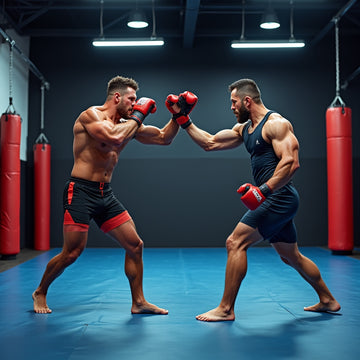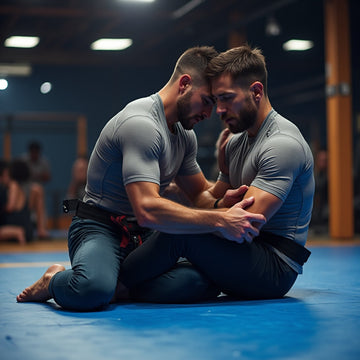Discover how the right fight shorts mobility can turn tight clinches into fluid transitions—move like water on the mats and the cage.
Introduction to Fight Shorts and Mobility
When you slip on a pair of fight shorts, you’re not just picking gear—you’re picking a partner for every takedown, guard pass, and scramble. For grapplers and strikers alike, those cuts, seams, and fabrics dictate how freely you can twist, pivot, and explode. Whether you’re hunting that perfect sweep in BJJ mobility shorts or seeking extra reach in MMA shorts flexibility, the right design can turn a static stance into dynamic flow. If you want more training drills, check out our BJJ mobility drills guide.
At first glance, all fight shorts look similar: sturdy waistbands, side slits, reinforced stitching. Yet subtle tweaks—the stretch panels, the length, even the velcro fly—reshape your range, comfort, and performance. Imagine two fighters: one restricted by his rigid gear, the other dancing around him. That contrast highlights why understanding fight shorts mobility is crucial, especially if you train several times a week and can’t afford gear that cranks your hips or binds your knees.
Key Design Features of Fight Shorts Impacting Mobility
Not all fight shorts are created equal. A few design hallmarks separate the agile from the average. First: side slits. These vertical cuts at the hem let your knees climb high without tugging at the fabric. Then there’s gusset design—a diamond-shaped panel that anchors seams away from pressure points. When you sit guard or scramble for underhooks, a gusset keeps the fabric from ripping or bunching under your groin. Learn more about material choices on our MMA shorts flexibility page.
Next, consider the waistband. Some brands use a mix of velcro and drawcord, so you can fine-tune tension mid-roll. Too loose? You’ll worry about an impromptu wardrobe malfunction. Too tight? Your lower back rebels. A mid-height, low-profile waistband strikes the ideal balance.
Fabric weight and finish matter as well. Lightweight weaves—think 4–6 oz—a breeze to move in but prone to snags. Heavier denier nylon holds up but can feel stiff unless it has a softer laminate or jersey-knit backing. Finally, look for flatlock stitching; it feels smooth against your skin and won’t irritate during extended training sessions.
Biomechanics: How Fight Shorts Influence Movement
You know what? Movement in grappling is a conversation between joints and fabric. If the fabric fights back, your hips, knees, and ankles must compensate—often by shifting into awkward ranges. That throws off timing, robs speed, and can even invite injury.
Imagine executing a deep half-guard transition. Your shin needs to rotate outward, your hip flexes deeply, and your ankle dorsiflexes. Shorts that aren’t engineered for that pathway will bunch at the crotch, anchor your thigh, and jam your circulation. The result? A restriction you feel as soon as you try to bridge or shrimp. Conversely, ergonomic design shorts BJJ makers integrate four-way stretch panels across the hip flexor and inner thigh zones. That targeted elasticity harmonizes with your natural arc, turning struggle into smooth extension.
Alongside elasticity, compression zones can improve proprioception. Slightly tighter patches around the quads or glutes remind you where your limbs sit, allowing micro-adjustments. It’s subtle, but you’ll notice the difference when you need to chain wrestle techniques without resetting your stance.
Comparing Fight Shorts to Rash Guards and Spats
We often slip on rash guards or spats for coverage, but can fight shorts match—or even outpace—them in mobility? The key difference is panel orientation and garment weight. Rash guards hug the torso, rarely restricting limb rotation, while spats stretch across the hips but lack reinforcement around high-wear zones. Fight shorts sit somewhere between: they’re looser than spats, more robust than leggings, and designed to withstand grips.
In BJJ you might prefer spats for compression and shin protection, but when you mix in strikes—especially knee kicks and low leg catches—you need shorts that shrug off pulls. A rash guard can slide up during a scramble; shorts with a secure waistband stay put.
That said, pairing shorts with quality spats underneath offers the best of both worlds: extra grip resistance, modesty, and layered glide. It’s a tandem approach, one that many professional gyms now recommend to maintain fluid motion and prevent mat burns.
Testing Fight Shorts: Real-World BJJ & MMA Scenarios
Bench testing in a shop is one thing; stepping onto the mat is another. A real-world trial highlights how fight shorts flex when you need them most. We took a few pairs—some with 10% stretch panels, others with 20%—and subjected them to guard passes, butterfly sweeps, and takedown drills. Predictably, heavier fabrics felt more anchored but offered less give in deep squats and half-guard entanglements. Lighter weaves moved beautifully but showed micro-tears along the waistband after several leg locks.
One standout: a pair reinforced at the seams yet surprisingly light. With just 12% elastane, they balanced flexibility and durability. During sprawling drills they never dug into the ribs, and when our training partner latched a tight rear-naked choke, the shorts adapted without binding.
Then there was the snap test—intensely shooting for double-leg takedowns. Shorts that hugged the hips too snugly created a vacuum effect, slowing drive momentum. Those with stretch-mesh panels in the inner thighs let our hips explode forward. Scorecard: you want some give—and the right patterning—to let your body express full force. Bone Reaper Fight Shorts nailed it here, handling sweeps and takedowns with minimal tug and optimal output.
Top Fight Shorts for Enhanced Mobility
After testing dozens of pairs, here are three that rose above the rest—each offering a unique spin on fight shorts mobility. Whether you lean toward grappling or striking, these picks deliver freedom and resilience.
| Model | Stretch % | Fabric | Durability Score | Price |
|---|---|---|---|---|
| Against All Gods Fight Shorts | 15% | 4-way stretch polyester blend | 9/10 | $59.99 |
| Angel of Death Fight Shorts | 18% | Poly/spandex double-knit | 8/10 | $64.99 |
| Baphomet’s Wrath Fight Shorts | 12% | Heavy denier nylon w/ mesh | 10/10 | $69.99 |
| Bone Reaper Fight Shorts | 14% | Ripstop polyester | 9/10 | $62.99 |
- Pros: High stretch, secure waistband, breathable panels.
- Cons: Pricier than basic models; requires machine wash on gentle cycle.
Training Tips to Maximize Mobility in Your Fight Shorts
Wearing fight shorts is one thing; training the right drills brings out their full potential. First off, practice shrimping and bridging in shirtless mode—feel how the shorts slide over your hips. Then add resistance bands around your knees to build abductors; you’ll notice how stretchy gear aids controlled movements. For more intensive workouts, refer to our training drills in fight shorts.
Incorporate dynamic lunges and hip internal/external rotation drills before your warm-up rolls. That preps the fibers of your shorts to flex instead of snap. When drilling guard retention, use light bungee cords around the ankles; it mimics opponent weight without tearing the fabric.
And don’t forget recovery. Post-training, hang-dry your shorts inside out; the gentle stretch during drying prevents shrinkage. For those who need a stylistic pick, Archangel Michael Fight Shorts combine aesthetics with performance, keeping seams aligned through repeated movements.
- Warm up with deep squats and hip circles to prime the panels.
- Use foam rolling on quads and IT bands to reduce fabric drag.
- Pair shorts with compression leggings for cold-weather sessions.
Care and Maintenance for Optimal Flexibility
How you wash and store your shorts affects their long-term flexibility. First rule: cold water only. Hot cycles break down elastic fibers faster, leaving you with stiff, less forgiving gear. Second: mild detergent without bleach. Strong chemicals can weaken stitching and degrade the waistband. For a deep dive, see our care and maintenance guide.
After washing, air-dry flat—never tumble-dry or iron. Heat tanks the elasticity and can warp printed logos. If you own Black Rose Madonna Fight Shorts, it’s best to turn them inside out so the decorative panels don’t fray.
Store your shorts flat or folded—no hanging from the waistband. Gravity stretches out that critical region. A simple drawer stack ensures the elastane stays evenly distributed until your next roll.
Conclusion: Are Fight Shorts Worth It for Mobility?
So, are fight shorts a game-changer for mobility in BJJ and MMA? Absolutely—when you’re selective about design, fit, and fabric. The right pair lets you execute deep guard passes, swift takedowns, and seamless scrambles without battling your own gear. Sure, cheaper options exist, but investing in quality mobility shorts pays off in training efficiency, injury prevention, and overall freedom of movement.
Whether you’re chasing that black belt or prepping for your first amateur bout, treat your fight shorts as an essential tool. Test multiple pairs, note the stretch-to-resistance ratio, and follow care guidelines. Before long, you’ll feel the difference every time you transition from stand-up to ground—and back again.
Updated: 08-24-2025









